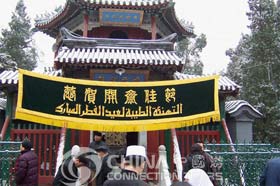
 The Ox Street Mosque, located in the Guang'anmennei area in the southwestern section of the city, the spiritual centre for the 10,000 Muslims living in the vicinity, is the oldest and largest of the 80 mosques in Beijing. The Islamic faith was introduced into China during the Tang Dynasty and has followers among more than 10 Chinese ethnic groups, including the Huis, Uygurs, Ozbeks and Kazaks. When it was first built some thousand years ago, the architecture of the Ox Street Mosque was in pure Arabic style. During its many phases of reconstruction and renovation, however, elements of Chinese traditional architecture were adopted. Today, in terms of its structure and general layout, Islamic features still prevail.
The Ox Street Mosque, located in the Guang'anmennei area in the southwestern section of the city, the spiritual centre for the 10,000 Muslims living in the vicinity, is the oldest and largest of the 80 mosques in Beijing. The Islamic faith was introduced into China during the Tang Dynasty and has followers among more than 10 Chinese ethnic groups, including the Huis, Uygurs, Ozbeks and Kazaks. When it was first built some thousand years ago, the architecture of the Ox Street Mosque was in pure Arabic style. During its many phases of reconstruction and renovation, however, elements of Chinese traditional architecture were adopted. Today, in terms of its structure and general layout, Islamic features still prevail.
The mosque was originally built by Nasruddin, the son of an Arabic priest who came to China to preach the Islamic faith in 996 (Northern Song Dynasty). Major renovation projects were carried out in 1442, during the time of Emperor Kangxi (1662-1722) and again after the founding of the People's Republic of China in 1949 when the buildings were entirely repainted and redecorated.
The prayer hall, with its courtyard to the east, consists of five major areas. The three central areas, running lengthwise, are divided into five bays, some narrow with coffered ceilings, and some wide with high-beam ceilings. The two side wings have plain ceilings with beams laid lengthwise. At the entrance of the hall, the ceiling bears the Arabic names of noted imams around the world. Farther in, Chinese flower and cloud paintings mingle with Arabic inscriptions and patterns on the coffered ceilings, and the chandeliers are slightly reminiscent of Venetian glass. There is an arch between each pair of pillars, gleaming with gold patterns.
 The minaret (calling tower), a two-storey obelisk in the centre of the courtyard, was originally built as a script depository. Later imams used it as a calling tower. When prayer time came, they ascended the tower and recited the Koran, and Muslims living in the vicinity came to listen. On the ground floor is a large copper cauldron, which was used to prepare communal meals.
The minaret (calling tower), a two-storey obelisk in the centre of the courtyard, was originally built as a script depository. Later imams used it as a calling tower. When prayer time came, they ascended the tower and recited the Koran, and Muslims living in the vicinity came to listen. On the ground floor is a large copper cauldron, which was used to prepare communal meals.
To the southeast of the tower lie the tombs of two Muslims who came from the Middle East and preached in the Mosque. The tomb for Ahmad Burdani was built in 1320, and the one for Ali in 1283. Both came from ancient Persia. The tombstones bear Arabic inscriptions and have been set into a nearby wall.
In the imam's library, there are Koran manuscripts and old wooden printing blocks. The mosque used to be a printing house as well.

